Physical Therapy Career Guide
You May Also Enjoy
Physical Therapy Schools: Everything You Need to Know
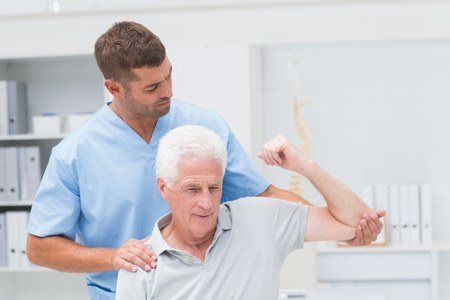
Physical therapy schools have come a long way since the profession was introduced almost a century ago.
Spurred by the polio epidemic and World War I, the U.S. army created a 3-month training program in 1917.
Over the next 100 years, physical therapy education evolved and today there are nearly 230 accredited physical therapy schools in the United States, producing thousands of PT’s helping patients with various injuries and conditions.
Here’s what you need to know to choose the best physical therapy school for you.
Physical Therapy Degrees
As physical therapy earned more recognition as a viable healthcare method, more physical therapy schools cropped up and certificates and bachelor’s degrees were born. Master’s degrees in PT soon followed, but today, all accredited schools offer one outcome: The Doctor of Physical Therapy (DPT).
What certification will I need?
In addition to your degree, you will also be required to pass national and state licensure exams in order to be certified to practice in your state. Every state’s exam is different, but your physical therapy program should have you adequately prepared to pass the test. If you choose to, you can become certified in a particular clinical specialty, like pediatric or sports physical therapy.
Since some physical therapy schools offer programs for specific certifications, you’ll need to research your school choices carefully to be sure that you’re preparing yourself for a certification that meets your goals.
What will I learn in my courses?
Earning a degree in physical therapy is a big commitment, but the right program will fully prepare you to take on the career. While your specific classes will vary somewhat by program, an example of a physical therapy school course list might include the following:
- Human anatomy
- Fundamentals of movement
- Research methods
- Clinical practice
- Exercise physiology
- Principles of exercise
- Kinesiology and biomechanics
How long will it take?
Your physical therapy program will take around two to three years to complete—and this is on top of the four years it will take to earn your undergraduate degree. Needless to say, all these years in school make earning your physical therapy degree a huge commitment. However, physical therapy school usually is worth the investment, as great earning opportunities make the financial and time investments worth it.
In order to become a physical therapist, you will need to earn your doctoral degree from a physical therapy program. In order to be accepted into a physical therapy program, you will need to hold a bachelor’s degree, and oftentimes, programs will require that your undergraduate hours include a specific number of science and health-based courses.
In the past, students had the choice between a master of physical therapy (MPT) or a doctor of physical therapy (DPT), but as of 2015, all accredited physical therapist programs are doctorate level.
PT programs recognize that aspiring physical therapists come from various backgrounds which is why there are multiple ways to earn your DPT. Which one fits your needs?
DPT (Traditional)
A traditional DPT program takes three years to complete and includes a comprehensive curriculum covering everything from physical therapy basics to professionalism to health and wellness. In order to apply to a DPT program, you need to have a bachelor’s degree, completed prerequisite science courses, and GRE scores.
Before you can enroll in a physical therapy program, you will need to earn a bachelor’s degree. The majority of physical therapy schools will require that you complete certain science and health-based courses during your undergrad studies. Bear in mind that there may also be GPA requirements for the physical therapy program you choose to enroll in, and if you did poorly in a required undergrad class, you could be asked to retake it.
Prerequisites don’t differ much by the school, but always check each program’s exact requirements. The following courses usually need to be completed before you can start a DPT program:

Chemistry with Lab

Human Anatomy with Lab

Biology

Physics with Lab

Statistics

Medical Terminology
If you missed any prerequisites during your undergraduate years, you can take basic science courses at a local community college.
Did You Know? Many physical therapist schools require students to have a certain number of observation hours under their belt in order to be accepted into a program.
Observation criteria—hours, paid vs. volunteer, type of setting—differ by school, but traditional DPT programs usually require between 60-100 hours of observation in order to matriculate.
Your first year in physical therapy school will be spent learning about the scientific foundation of physical therapy with an introduction to the physical therapy profession. The curriculum builds upon these courses for the last two years while incorporating clinical experience.
Year Two
| What You’ll Learn | Coursework focuses on musculoskeletal and neuromuscular systems. Pediatric and geriatric populations are also discussed. Students are taught about amputee rehabilitation, orthotics, and prosthetics. |
| What You’ll Do | Lab work and clinical education |
Year Three
| What You’ll Learn | In your final year, you’ll spend time learning about business management, ethics, and patient/client education. |
| What You’ll Do | Clinical internship and capstone project |
As you scan school curriculums, you’ll notice one or two pharmacology courses. Not to worry, physical therapy hasn’t abandoned its natural approach to healing. The pharmacology classes are intended to teach students how medicine can affect tissue from healing. Since you’ll encounter patients on medication throughout your career, you’ll need to have a deep understanding of how it affects the job you do. You’ll learn about naturopathic remedies as well.
BS/DPT
No bachelor’s degree? No problem. Some schools offer an accelerated BS/DPT program or 3+3 physical therapy specialization.
You enter school as a freshman, but you’ll graduate in six years as a Doctor of Physical Therapy. Unlike a typical bachelor’s degree program where you can choose any major, a 3+3 program is designed with a specific undergraduate track. This means that “picking your major” happens before you apply. When researching different 3+3 physical therapy schools, you may come across the following majors to choose from:

Natural Science

Exercise Science

Health Science

Life Science

Athletic Training

Biology
Read each program description carefully to determine which direction you want to take in your undergraduate education. For instance, a BS in exercise science is likely to focus heavily on nutrition and fitness assessment whereas a health studies major will include more classes on chemistry, biology, brain function, and advocacy.
DPT schools have high standards for their students and 3+3 programs are no exception. In order to move to the graduate-level portion of the program, students usually need to receive a C or higher in each class.
It’s recommended that you work with a school advisor throughout the first three years to ensure you’re taking courses in the appropriate sequence and completing the correct prerequisites.
Once you reach the DPT level of the program, you can expect the same types of classes as a traditional DPT program. Upon graduating, you should feel prepared for the National Physical Therapy Exam (NPTE).
Freshman-to-Doctorate

Some physical therapy schools offer a unique degree track for high school students: The freshman-to-doctorate, or Direct Freshman Entry, option.
These physical therapy programs are also accelerated—six years in length—compared to the seven years you’d spend taking the traditional route.
How it works: Just as you would choose a major in any other undergraduate program, you’ll do the same in a freshman-to-doctorate track. Students usually earn a bachelor of science in biology, sports studies, physiological sciences, or health services.
Even though each major will prepare you for a DPT program, you’ll want to choose one that also fits your career goals. For example, if you’re interested in working with athletes, the sports studies major is a natural choice.
Choose a Biology major if you’re looking for a thorough understanding of the sciences prior to the DPT program.
Choose a Physiology major if you’re interested in gaining in-depth knowledge of the human body’s processes.
Choose a Health Services major if you want an education on health laws and running a practice.
By earning an undergraduate degree in one of these areas, you’ll be better prepared for the intricacies of a physical therapy program.
Undergraduate Class Prepares You For:
Human Anatomy
Medical Terminology
Principles of Sociology
Organic Chemistry
Physiology
DPT Class
Life Span Development
Wound Care Management
Patient/Client Management
Pharmacology
Physiology of Activity
DPT for Practicing Physical Therapists (Transitional DPT)
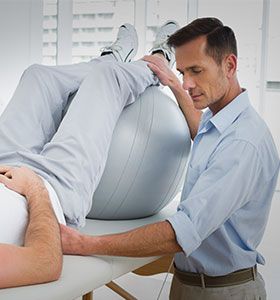
Although physical therapy master’s degree programs are now obsolete, there are plenty of PTs who hold this degree.
However, as the entire industry moves to a doctorate degree, it makes sense for practicing physical therapists to head back to school.
Transitional DPT (t-DPT) programs are designed to help practicing physical therapists increase their knowledge base, improve their skills in evidence-based practice and better understand the business of physical therapy. Although PTs are at the forefront of natural health treatments, a transitional DPT program highlights the latest advancements in wellness and new ways to promote healthy habits in patients.
If you’re thinking, “I’m doing just fine with my MPT degree,” here are three reasons why you should consider earning a DPT:
More knowledge: Enhance your clinical skills and learn the latest advances in physical therapy.
Stay competitive: As new DPT graduates enter the field, patients may seek out professionals with a higher degree. Earning a transitional DPT prevents you from lagging behind.
Prepare now: There could come a time when all PTs will need a DPT in order to be licensed.
If you have concerns about how you’ll fit school into a busy schedule, think about online learning. Online transitional DPTs are prevalent since these programs are designed for a working physical therapist. Many programs offer self-paced classes that can be completed in a year.
Did You Know? DPTs are considered professional, or entry-level, degrees. Advanced clinical science degrees, such as the Doctor of Physical Therapy Science (DPTSc), go a step further by training students in advanced research.
Clinical Experience
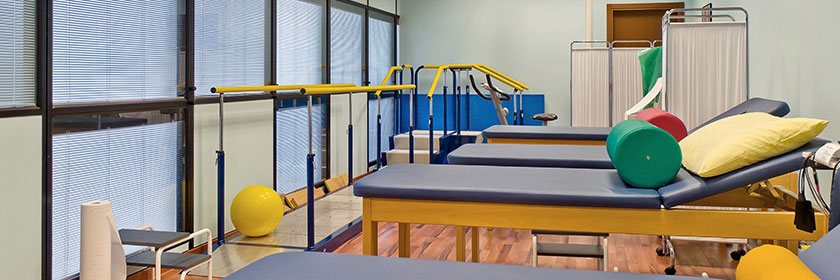
Some of your most important learning experiences will occur outside the classroom. Physical therapist schools design their curriculums with a significant focus on clinical experience. Students not only learn in a real-life setting under the supervision of a licensed PT but they’re expected to be immersed in diverse environments.
When you’re deciding between physical therapist schools, you should consider the clinical experience requirements. Some programs require students to participate in clinical rotations outside of the town or city the campus is located in.
Physical therapy clinical experiences vary, but here are a few types of scenarios to review.
- Practice setting minimums: Some schools require students to gain experience in at least three settings. While it may feel like a hassle to coordinate this many rotations, the purpose is to expose students to a wide range of patients and circumstances.
- Specific setting requirements: Rural or urban? Outpatient or inpatient? Each location requires students to employ different skills they’ve learned and problem-solving based on the setting. For instance, a student may need to determine how to practice in a rural clinic with fewer resources than, say, a large urban hospital.
- Specializations: DPT classes will cover all types of populations and specializations over the 3-year curriculum, however, a clinical experience is when you can hone your skills in a certain area. Students interested in pediatrics, orthopedics, geriatrics, or other areas typically have the option to choose a setting that matches their specialization interest. One school, D’Youville College, has a hippotherapy clinical site allowing students to gain experience in physical therapy using horses.
Clinical education hours vary by school. For example, some require 38 weeks while other programs want students to complete as many as 50 weeks in clinical internships. Typically, the rotations are done in 6, 8, or 12-week segments with the first one usually occurring after the first year. Once you complete a clinical rotation, you’ll be asked to provide an assessment of the experience, instruction, and clinical instructors (CIs).
Although a clinical is full-time, you’ll still be required to complete coursework along the way. If your clinical setting isn’t in the same area as your campus, you’ll participate in distance learning classes.
5 Tips for Out-of-Town Clinical Rotations
If you choose a school that requires relocation for clinical rotations, you may be concerned about how this could affect your finances since most students do not receive a stipend.
- Review the locations your school is affiliated with. Talk to a school advisor about the expected living costs in different cities and towns.
- Factor in travel costs. If you have to fly somewhere, you’ll need to budget for round-trip airline tickets.
- If any of your fellow students are heading to the same location, talk about sharing a short-term living space.
- Don’t forget about these additional costs if you plan to use school loans to pay for your living expenses.
- If it’s possible, find a clinical location in a city where you could stay with family or friends.
Physical Therapy School Accreditation
The Commission on Accreditation in Physical Therapy Education (CAPTE) is the federally-approved agency that gives its approval to DPT programs. It provides the official regularly-updated list of accredited schools, but don’t confuse this with ranking. The organization is crystal-clear in its stance that they do not weigh one school over another. If you’ve come across a program you’re interested in, your first step should be checking with CAPTE to ensure the program is accredited.
4 Reasons Why CAPTE Accreditation Matters
- Student outcomes have been reviewed and deemed acceptable
- Ensures the curriculum prepares students to work as a physical therapist
- Ensures the school is legitimate and doesn’t provide false information to students
- In order to take the licensing exam, your degree must come from an accredited school
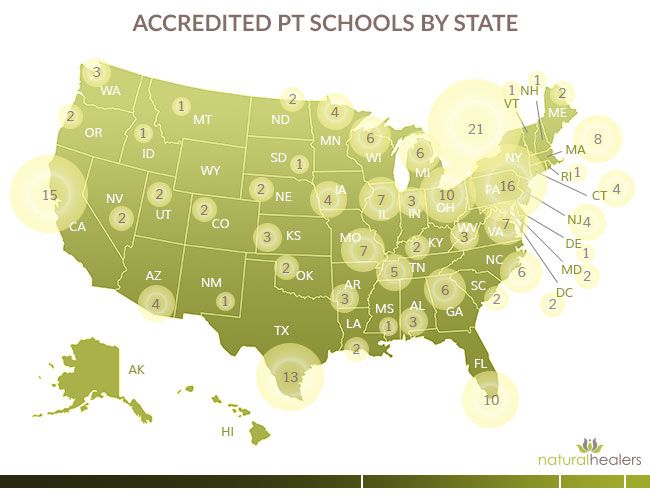
School Application Process
Applying to multiple schools can be time-consuming, but the physical therapy industry has streamlined the process for program applications.
The Physical Therapist Centralized Application Service (PTCAS) is an online application that aspiring students can use to apply to several physical therapy schools at one time.
Since it’s a web-based system, you can access it from anywhere and because it’s a standardized application, you only need one copy of recommendation letters, transcripts, and test scores.
While it offers plenty of conveniences, you need to pay attention to details and plan ahead. PTCAS warns that it can take a month or longer to process your application and it’s still the student’s responsibility to ensure the application is complete.
You can check the PTCAS website to learn which schools use the service.
Physical Therapy School Rankings
While CAPTE and the American Physical Therapy Association (APTA) don’t rank schools, there are some sources that list the best physical therapy schools based on different criteria.

U.S. News & World Report: Known for their prolific school rankings, U.S. News & World Report last surveyed CAPTE-accredited schools in 2020. Peer assessments were sent to deans, faculty, and administrators at accredited physical therapy schools across the country. Participants were asked to rate the academic quality of a physical therapy program with five being “outstanding” and one being “marginal.”
Start Class: Operated by a technology company that collects data in various fields, Start Class ranks physical therapy schools using a slightly more objective approach than U.S. News & World Report. Instead of relying on opinions, the rankings are based on student outcomes, student-faculty ratio, the amount of clinical experience required, and other facts.
But how important are physical therapy school rankings anyway?
Physical therapy school rankings shouldn’t be the only factor you consider when evaluating a program. If you’re not sure where to start your search, rankings can be a good jumping-off point since you can familiarize yourself with viable school options.
However, your decision should truly be based on how a school fits with your career goals and lifestyle needs. The University of Delaware may be ranked No. 1 by U.S. News & World Report, but if you live across the country with no plans to move, it really isn’t the No. 1 school for you.
Another important point to remember: Ranked schools are accredited by CAPTE which means they’ve all demonstrated a quality physical therapy education that meets strict standards.
Rankings can be a useful tool, but they’re just one piece of the puzzle. Consider the following factors:
| Teaching Style | What is the physical therapy program’s philosophy? Does it mesh with your learning style? |
| Exam Pass Rates | How many students are passing the national physical therapy exam on their first try? Higher numbers hint at a solid program with effective faculty. |
| Graduation Rates | A high graduation rate implies students were satisfied with the quality of a program and were adequately challenged. |
| Faculty | Does the faculty have extensive experience in the physical therapy field? Where has their work been published? Are they well-versed in any specialties? |
| Clinical Requirements | Are you comfortable with the number of clinical hours you’ll receive? Will out-of-state travel have an impact on your finances? Are the rotations varied enough so you’ll gain knowledge in multiple areas? |
| Cost | A DPT program is an investment in both time and money. Physical therapists make an annual median income of $95,620. Consider this number as you weigh tuition costs and future loan payments. |
Online Physical Therapy Schools

Physical therapy school can be described in two ways: Intensive and hands-on. In fact, some schools recommend students forgo working during the program. That’s not realistic for everyone, however, and online programs are known for their flexibility.
Because of the rigorous coursework and necessary lab and clinical work, CAPTE doesn’t accredit physical therapy programs that exist completely online. While some schools offer certain classes as a distance-learning option, students are expected to be present for a range of classroom and lab activities.
If you’re concerned about balancing work and physical therapy school, narrow your search down to accredited programs with an online component.
How Much Does Physical Therapy School Cost?
It’s no secret that getting an education is expensive. As you prepare for physical therapy school, one of the biggest factors you’ll need to consider is the cost, especially if you’re already saddled with undergraduate loans.
According to APTA, the 2013 tuition rates per year (the most recent available) looked like this:
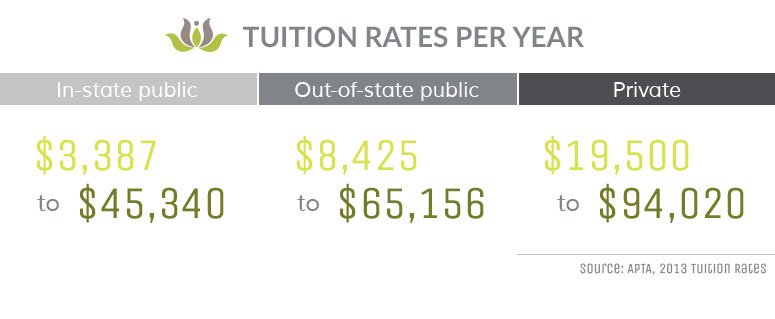
And remember, this is just tuition. You’ll also need to factor in the cost of books, additional fees, and living expenses.
Paying for Physical Therapy School
As long as you attend an accredited physical therapy school, you’ll be eligible for federal financial aid. This can come in the form of loans and grants. Scholarships and grants—which you don’t have to pay back—are often awarded by community groups, nonprofit organizations, professional associations, and private individuals as well. You may have to spend some time digging for financial awards that you’re eligible for, but it can be worth it.
If you need to take out loans to pay for school, don’t be discouraged. There are several loan forgiveness or repayment options that you may be eligible for in the future. In fact, knowing about them now may encourage you to seek a certain career path as a physical therapist.
- Public Service Loan Forgiveness Program: Full-time therapists working at nonprofit organizations, in a government setting, or in a public health environment may be eligible for loan forgiveness. You’ll be responsible for 120 monthly payments before you can apply.
- National Institutes of Health Loan Repayment Program: Interested in research? You may be able to receive up to $35,000 a year in loan repayment. Physical therapists with a doctorate who conduct clinical research are eligible. You can find the full details on the NIH website.
- Faculty Loan Repayment Program: Physical therapists from disadvantaged backgrounds who commit to at least two years of work at a health institution may be eligible for up to $40,000 in loan repayment. This is a great opportunity to teach future generations about physical therapy and promote the profession.
Loan Tips:
- When possible, borrow from the federal government instead of a private lender. Federal loans usually have lower interest rates, better repayment plans, and deferment options.
- Understand the difference between unsubsidized and subsidized. You’re responsible for the interest while you’re in school with an unsubsidized loan whereas the government will cover the interest during school with a subsidized loan.
- Know how much you can borrow as a graduate student. There are limits depending on the type of loan you receive. For instance, you can borrow up to $20,500 per year with a Direct Unsubsidized loan, but only up to $8,000 with a Perkins Loan (depending on need).
APTA and the U.S. Department of Education are both good resources for additional information on paying for school.
Physical Therapist Assistants and Aides: A Stepping Stone?
Physical therapist assistants or aides (PTAs) are an integral part of physical therapy practice. Working under the supervision of a physical therapist, PTAs have direct contact with patients by helping them with certain exercises and observing their progress. They also help in other areas of practice such as preparing equipment, cleaning, and completing administrative tasks.
PTAs need an associate’s degree in order to work. Coursework is a blend of both general education and physical therapy topics.
While the job of a PTA can certainly provide insight into a physical therapist’s career, it’s not common for PTAs to take that route. According to the American Physical Therapy Association, only about 10% of physical therapist assistants actually pursue a DPT. In fact, APTA explicitly states that PTAs shouldn’t view this career path as a stepping stone toward a physical therapy career.
This isn’t to say a PTA career is a waste of time if you want to become a physical therapist. The time spent working under the supervision of a PT can provide valuable insight if you’re not 100% sure you want to become a physical therapist. Working as a PTA allows you to test the waters, so to speak.
If you’re already working as a PTA and want to become a physical therapist, this shouldn’t discourage you. Just be aware that credits you completed in an associate’s degree program may not transfer into a graduate-level program.
The other obstacle? Most DPT programs require students to have a bachelor’s degree before enrolling.
Tips
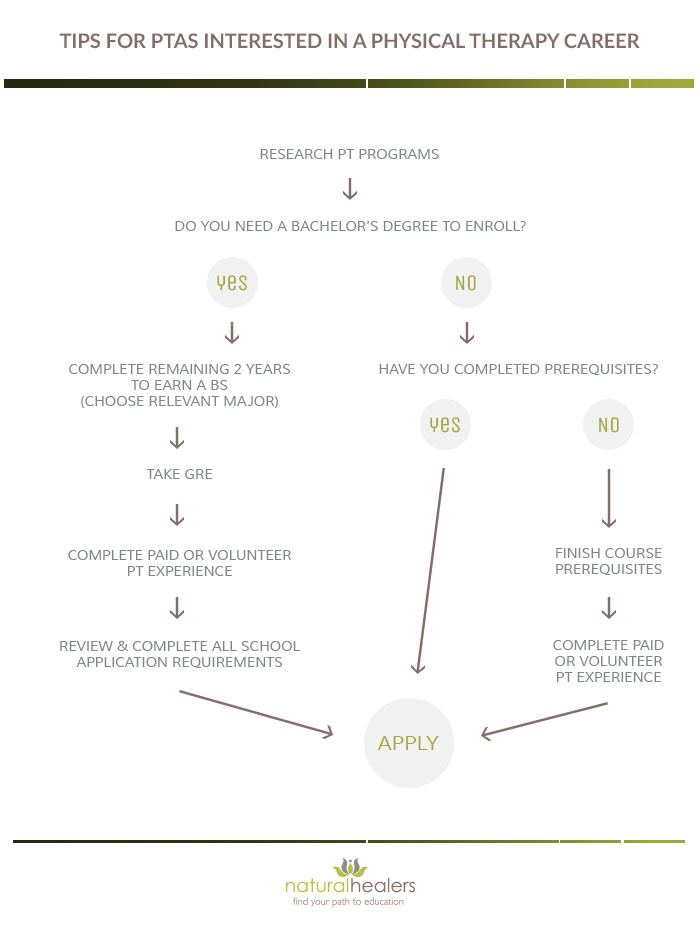
Physical Therapy School: An Ongoing Education

Unlike other health-related graduate programs, such as nursing, physical therapy schools usually don’t offer a specialized track for students. Instead, the DPT program is a comprehensive curriculum that touches on all areas of the profession.
If you want to specialize in a certain area of physical therapy, you have the choice of completing a post-professional residency or fellowship. There are currently 185 residency programs accredited by the American Board of Physical Therapy Residency and Fellowship Education (ABPTRFE) and 36 fellowship programs with ABPTRFE’s approval.
Residencies provide mentors and allow you to train further in a specialized area, such as pediatrics. Although much of your time will be spent in a clinical setting, you’ll also participate in case reviews, problem-solving scenarios, and classroom instruction. The advanced knowledge you gain from a residency can prepare you to be a leader in your field and potentially jumpstart exciting career opportunities.
What you need: A Doctor of Physical Therapy degree and an active license in the state where the residency is located.
Physical therapy fellowships break down specializations even further. In order to apply for a fellowship, you first need to complete a residency in a related area. Fellowships aren’t open to new DPT graduates.
As you begin your search for a physical therapy school, keep in mind that many factors will lead you to a decision. Visit different schools to see their facilities and talk to current DPT students. Ask an important question: Will this physical therapy school help me achieve my goals of helping others live a better life?
